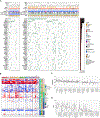The genomic and evolutionary landscapes of anaplastic thyroid carcinoma
- PMID: 38412093
- PMCID: PMC11077417
- DOI: 10.1016/j.celrep.2024.113826
The genomic and evolutionary landscapes of anaplastic thyroid carcinoma
Abstract
Anaplastic thyroid carcinoma is arguably the most lethal human malignancy. It often co-occurs with differentiated thyroid cancers, yet the molecular origins of its aggressivity are unknown. We sequenced tumor DNA from 329 regions of thyroid cancer, including 213 from patients with primary anaplastic thyroid carcinomas. We also whole genome sequenced 9 patients using multi-region sequencing of both differentiated and anaplastic thyroid cancer components. Using these data, we demonstrate thatanaplastic thyroid carcinomas have a higher burden of mutations than other thyroid cancers, with distinct mutational signatures and molecular subtypes. Further, different cancer driver genes are mutated in anaplastic and differentiated thyroid carcinomas, even those arising in a single patient. Finally, we unambiguously demonstrate that anaplastic thyroid carcinomas share a genomic origin with co-occurring differentiated carcinomas and emerge from a common malignant field through acquisition of characteristic clonal driver mutations.
Keywords: CP: Cancer; CP: Genomics; anaplastic thyroid cancer; cancer progression; genomics; tumour evolution; tumour heterogeneity.
Copyright © 2024 The Author(s). Published by Elsevier Inc. All rights reserved.
Conflict of interest statement
Declaration of interests All authors declare that they have no competing interests.
Figures





References
-
- Bruinsma SM, Roobol MJ, Carroll PR, Klotz L, Pickles T, Moore CM, Gnanapragasam VJ, Villers A, Rannikko A, Valdagni R, et al. (2017). Expert consensus document: Semantics in active surveillance for men with localized prostate cancer - results of a modified Delphi consensus procedure. Nat. Rev. Urol. 14, 312–322. 10.1038/nrurol.2017.26. - DOI - PubMed
-
- Bayani J, Yao CQ, Quintayo MA, Yan F, Haider S, D’Costa A, Brookes CL, van de Velde CJH, Hasenburg A, Kieback DG, et al. (2017). Molecular stratification of early breast cancer identifies drug targets to drive stratified medicine. NPJ Breast Cancer 3, 3. 10.1038/s41523-016-0003-5. - DOI - PMC - PubMed
Publication types
MeSH terms
Grants and funding
LinkOut - more resources
Full Text Sources
Medical
Miscellaneous

